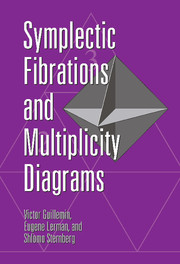Book contents
- Frontmatter
- Contents
- Acknowledgments
- Introduction
- 1 Symplectic Fibrations
- 2 Examples of Symplectic Fibrations: The Coadjoint Orbit Hierarchy
- 3 Duistermaat–Heckman Polynomials
- 4 Symplectic Fibrations and Multiplicity Diagrams
- 5 Computations with Orbits
- Appendix A Multiplicity Formulas
- Appendix B Equivariant Cohomology
- Appendix C Update
- Bibliography
- Index
Introduction
Published online by Cambridge University Press: 03 February 2010
- Frontmatter
- Contents
- Acknowledgments
- Introduction
- 1 Symplectic Fibrations
- 2 Examples of Symplectic Fibrations: The Coadjoint Orbit Hierarchy
- 3 Duistermaat–Heckman Polynomials
- 4 Symplectic Fibrations and Multiplicity Diagrams
- 5 Computations with Orbits
- Appendix A Multiplicity Formulas
- Appendix B Equivariant Cohomology
- Appendix C Update
- Bibliography
- Index
Summary
Multiplicity diagrams are convenient ways of depicting certain phenomena in the representation theory of Lie groups. Given a compact Lie group G and a unitary representation p of G on a finite-dimensional Hilbert space, p can be completely described by listing the multiplicity with which each irreducible representation of G occurs in p. Suppose now that we are given a scheme for indexing the irreducible representations of G. Then the multiplicity diagram attached to p will be a diagram that displays the indexing set and labels each point in the set with the multiplicity with which that point occurs in p. For instance, suppose G = Tn = the real n-dimensional torus. Then the irreducible representations of G are indexed by the points on the n-dimensional lattice ℤn, and a multiplicity diagram will consist of a subregion Δ of ℤn -space with an integer-valued function m defined on it. The subregion Δ will be, essentially, the support of m. In the case of primary interest to us, the function m itself will be given by an explicit formula – the celebrated Kostant multiplicity formula. As is frequently the case with explicit formulas, the formula, although explicit, is extremely difficult to evaluate. The methods of this monograph will give us an effective way of making approximate computations with this formula using techniques from symplectic geometry. We will actually be interested less in the multiplicity diagrams themselves than in certain “asymptotic” versions of them.
- Type
- Chapter
- Information
- Symplectic Fibrations and Multiplicity Diagrams , pp. xi - xivPublisher: Cambridge University PressPrint publication year: 1996

